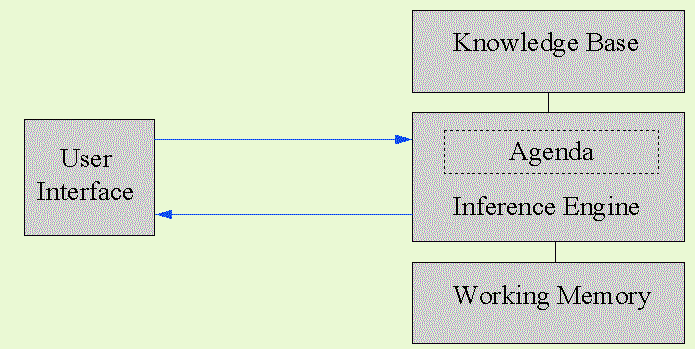 |
| Module 1 | Module 3 |
 |
Salience is a mechanism used by some expert systems to add a procedural aspect to rule inferencing. Certain rules may be given a higher salience than others, which means that when the inference engine is searching for rules to fire, it places those with a higher salience at the top of the agenda.
There are two types of chaining: forward and backward. In forward chaining, the expert system is given data and chains forward to reach a conclusion. In backward chaining, the expert system is given a hypothesis and backtracks to check if it is valid.
Inferencing is to computers what reasoning is to humans.
If the light is green then OK to cross the street cf 0.9The rule in the example says: I am 90% certain that it is safe to cross the street when the light is green.
There are certain advantages and disadvantages to certainty factors. They are easy to compute and can be used to easily propagate uncertainty through the system. However, they are created partly ad hoc. Also, the certainty factor of two rules in an inference chain is calculated as independent probabilities.
Dempster-Shafer Theory does not force belief to be assigned to ignorance or refutation of a hypothesis. For example, belief of 0.7 in falling asleep in class does not mean that the chance of not falling asleep in class is 0.3
Bayesian Networks are based on Bayes Theorem:
P(H|E) = P(E|H)P(H)
----------
P(E)
Bayes Theorem gives the probability of event H given that event E has
occurred. Bayesian networks have their use, but are often not practical for
large systems. There is also a problem with the uncertainty of user responses.
Some people think that fuzzy logic is a contradiction of terms. Fuzzy logic is a logic OF fuzziness, not a logic which is ITSELF fuzzy. Fuzzy sets and logic are used to represent uncertainty, which is crucial for the management of real systems. A fuzzy expert system is an expert system that uses a collection of fuzzy membership functions and rules to reason about data. Every rules fires to some degree.
The fuzzy inferencing process becomes much more complicated, expanding to 4 steps:
| You must have Netscape 2.0 to do the Post Test, or you will crash! | ||
| Module 1 | Post Test | Module 3 |
![]() For more
information send mail to: keg@csl.carlisle.army.mil
For more
information send mail to: keg@csl.carlisle.army.mil